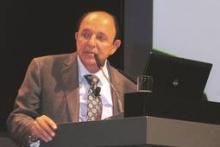VIENNA – Adding agents from two relatively new oral hypoglycemic drug classes to metformin produced a rapid, incremental reduction in hemoglobin A1c of more than 1% in two separate, phase III randomized controlled trials of patients with type 2 diabetes.
The efficacy and safety shown in the studies raises the possibility of formulating such three-agent combinations into single-pills, said Dr. Ralph A. DeFronzo, lead investigator for one of the studies.
The results “open the way to thinking about triple combinations. The next step is to concoct a single tablet with all three drugs together,” said Dr. DeFronzo at the annual meeting of the European Association for the Study of Diabetes.
The concept of treating patients with type 2 diabetes who fail to receive adequate glycemic control from diet and metformin treatment with the simultaneous addition of a drug from the sodium-glucose co-transporter 2 (SGLT-2) inhibitors class and a drug from the dipeptidyl peptidase-4 (DPP-4) inhibitor class “represents a new, proactive treatment paradigm, and appears to be an attractive option to safely and effectively bring difficult-to-treat metformin-failure patients to individualized glycemic goals,” said Dr. Julio Rosenstock, lead investigator for the second reported study and an endocrinologist at the University of Texas Southwestern Medical Center.
The study results reported by Dr. DeFronzo came from 677 patients with a HbA1c level of 7%-10% despite treatment with a stable metformin regimen for at least 12 weeks. Patients averaged about 56 years of age, and about three-quarters had been diagnosed with diabetes for more than 5 years. The researchers maintained all patients on their metformin dosage and randomized them to any of five treatment arms: 10 mg daily of the SGLT2 inhibitor empagliflozin (Jardiance), 25 mg daily empagliflozin, 5 mg daily of the DPP-4 inhibitor linagliptin (Trajenta), and two combination regimens: 5 mg linagliptin and 10 mg empagliflozin, and 5 mg linagliptin and 25 mg empagliflozin. The study’s primary endpoint was change from baseline in HbA1c after 24 weeks on treatment.
The results showed and average 1.19% drop in HbA1c after 24 weeks in patients on triple treatment with the higher dosage of empagliflozin, a 1.08% reduction in patients on the lower-dose, triple-treatment combination, and reductions that ranged from 0.62%-0.70% among the patients who received just one drug added to metformin. The differences between patients on either triple regimen and those on the three different dual regimens were statistically significant.
“Clearly, the combinations [of empagliflozin and linagliptin] have a greater effect than either of the drugs alone, but the effect is not completely additive,” noted Dr. DeFronzo, professor and chief of diabetes at the University of Texas Health Science Center, San Antonio.
The results also showed an average reduction in systolic blood pressure of 3-4 mm Hg among patients on triple therapy, similar to the effect from adding empagliflozin alone. The triple combinations were well tolerated, with a safety profile similar to monotherapy with these approved drugs, and confirmed hypoglycemia rates of 2%-4%, also similar to the rates seen with these drugs when used singly in combination with metformin.
The second study randomized 534 patients with a HbA1c level of 8%-12% while on stable metformin treatment. They averaged 53 years of age and had an average HbA1c of 8.9%. In addition to remaining on metformin, the researchers assigned patients to receive 10 mg of dapagliflozin (Farxiga) daily, 5 mg saxagliptin (Onglyza) daily, or a regimen that included all three drugs.
After 24 weeks on treatment, patients on the triple-drug regimen had an average reduction in HbA1c of 1.5%, while those on dapagliflozin plus metformin averaged a 1.2% reduction, while those on saxagliptin plus metformin had an average 0.9% drop. The differences between the triple-drug group and each of the two-drug groups were statistically significant for the study’s primary endpoint. The percentage of patients who achieved a HbA1c of less than 7% was 41% for patients on all three drugs, 22% for those on dapagliflozin plus metformin, and 18% for those on saxagliptin and metformin.
Patients on all three drugs also showed weight loss and blood pressure reductions roughly similar to the higher rates seen in the two control arms. The triple regimen was also well tolerated, with one patient having a minor hypoglycemic episode.
The empagliflozin and linagliptin study was sponsored by Boehringer Ingelheim, which markets both drugs. The dapagliflozin plus saxagliptin study was sponsored by Bristol-Myers Squibb and AstraZeneca, which market both drugs. Dr. DeFronzo is an adviser to and speaker for Boehringer Ingelheim, Bristol-Myers Squibb, AstraZeneca, and other drug companies. Dr. Rosenstock is a consultant to Boehringer Ingelheim, Bristol-Myers Squibb, AstraZeneca, and other drug companies.




